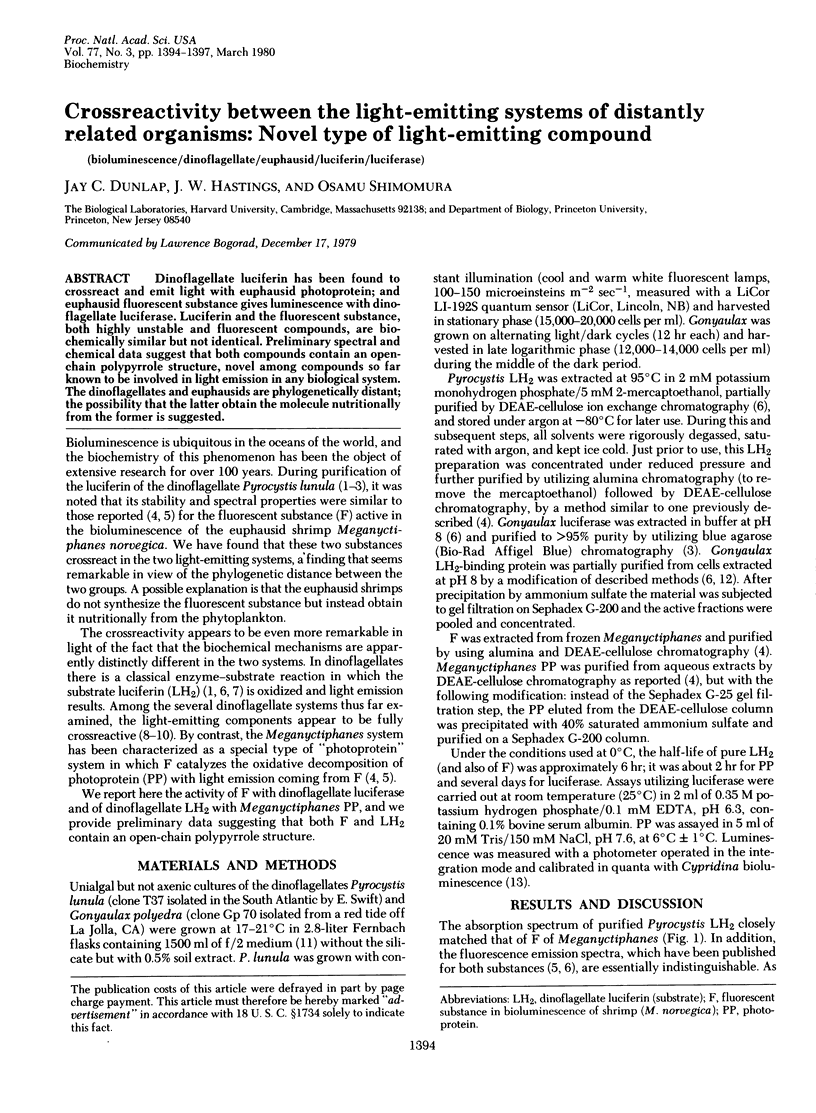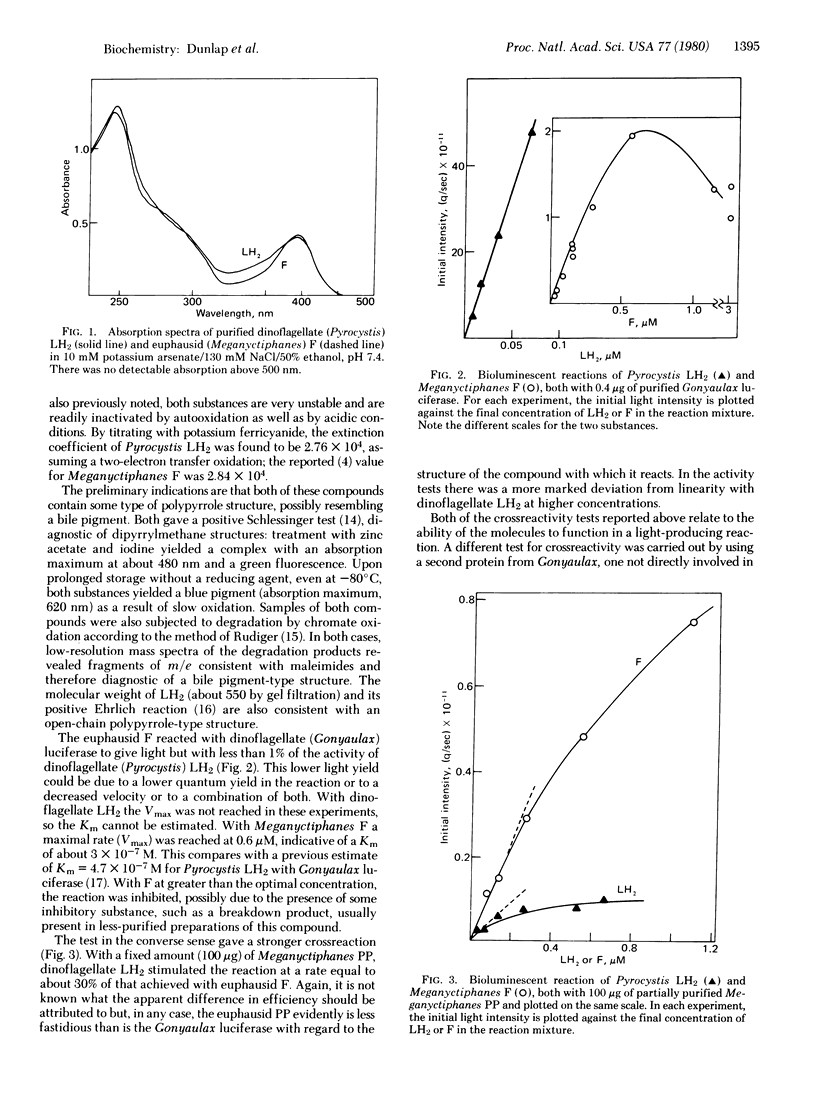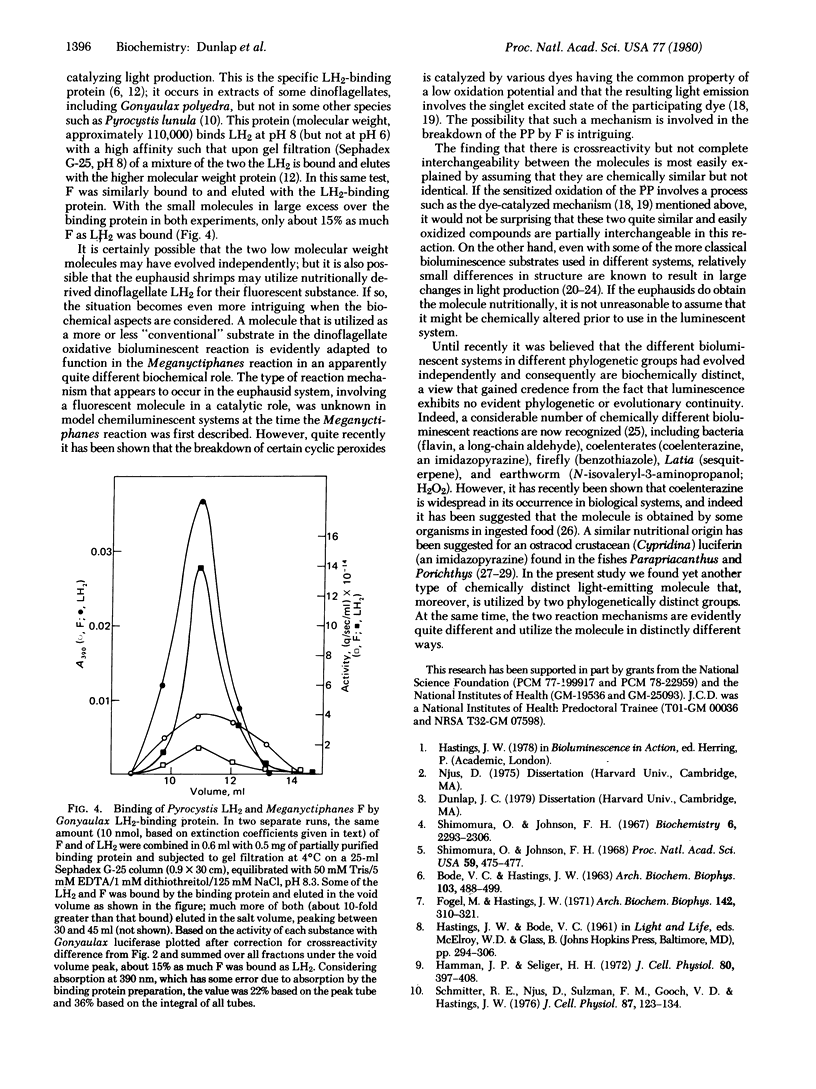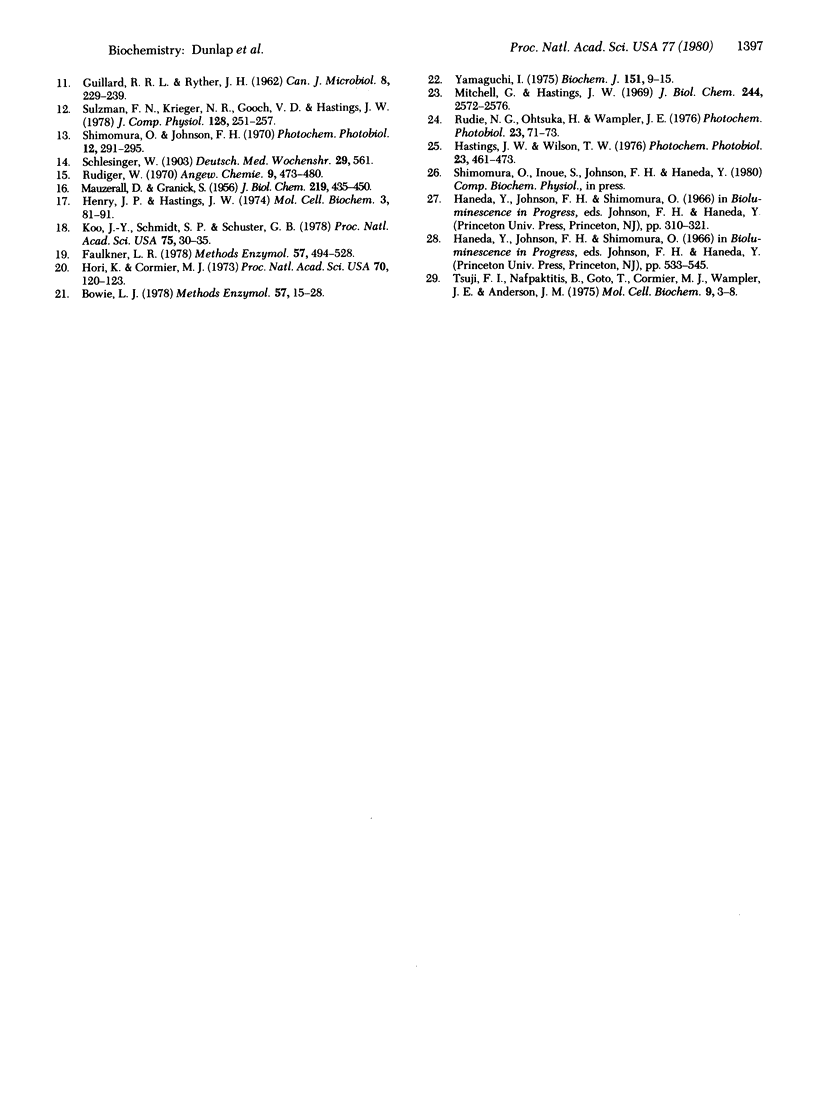Abstract
Dinoflagellate luciferin has been found to crossreact and emit light with euphausid photoprotein; and euphausid fluorescent substance gives luminescence with dinoflagellate luciferase. Luciferin and the fluorescent substance, both highly unstable and fluorescent compounds, are biochemically similar but not identical. Preliminary spectral and chemical data suggest that both compounds contain an open-chain polypyrrole structure, novel among compounds so far known to be involved in light emission in any biological system. The dinoflagellates and euphausids are phylogenetically distant; the possibility that the latter obtain the molecule nutritionally from the former is suggested.
Keywords: bioluminescence, dinoflagellate, euphausid, luciferin, luciferase
Full text
PDF



Selected References
These references are in PubMed. This may not be the complete list of references from this article.
- BODE V. C., HASTINGS J. W. THE PURIFICATION AND PROPERTIES OF THE BIOLUMINESCENT SYSTEM IN GONYAULAX POLYEDRA. Arch Biochem Biophys. 1963 Dec;103:488–499. doi: 10.1016/0003-9861(63)90442-9. [DOI] [PubMed] [Google Scholar]
- Fogel M., Hastings J. W. A substrate-binding protein in the Gonyaulax bioluminescence reaction. Arch Biochem Biophys. 1971 Jan;142(1):310–321. doi: 10.1016/0003-9861(71)90289-x. [DOI] [PubMed] [Google Scholar]
- GUILLARD R. R., RYTHER J. H. Studies of marine planktonic diatoms. I. Cyclotella nana Hustedt, and Detonula confervacea (cleve) Gran. Can J Microbiol. 1962 Apr;8:229–239. doi: 10.1139/m62-029. [DOI] [PubMed] [Google Scholar]
- Hamman J. P., Seliger H. H. The mechanical triggering of bioluminescence in marine dinoflagellates: chemical basis. J Cell Physiol. 1972 Dec;80(3):397–408. doi: 10.1002/jcp.1040800310. [DOI] [PubMed] [Google Scholar]
- Hastings J. W., Wilson T. Bioluminescence and chemiluminescence. Photochem Photobiol. 1976 Jun;23(6):461–473. doi: 10.1111/j.1751-1097.1976.tb07282.x. [DOI] [PubMed] [Google Scholar]
- Henry J. P., Hastings J. W. Solubilization of molecular elements of scintillons: bioluminescent particles from dinoflagellates. Mol Cell Biochem. 1974 Apr 15;3(2):81–91. doi: 10.1007/BF01659180. [DOI] [PubMed] [Google Scholar]
- Hori K., Cormier M. J. Structure and chemical synthesis of a biologically active form of renilla (sea pansy) luciferin. Proc Natl Acad Sci U S A. 1973 Jan;70(1):120–123. doi: 10.1073/pnas.70.1.120. [DOI] [PMC free article] [PubMed] [Google Scholar]
- Koo J. A., Schmidt S. P., Schuster G. B. Bioluminescence of the firefly: key steps in the formation of the electronically excited state for model systems. Proc Natl Acad Sci U S A. 1978 Jan;75(1):30–33. doi: 10.1073/pnas.75.1.30. [DOI] [PMC free article] [PubMed] [Google Scholar]
- MAUZERALL D., GRANICK S. The occurrence and determination of delta-amino-levulinic acid and porphobilinogen in urine. J Biol Chem. 1956 Mar;219(1):435–446. [PubMed] [Google Scholar]
- Mitchell G., Hastings J. W. The effect of flavin isomers and analogues upon the color of bacterial bioluminescence. J Biol Chem. 1969 May 25;244(10):2572–2576. [PubMed] [Google Scholar]
- Rudie N. G., Ohtsuka H., Wampler J. E. Purification and properties of luciferin from the bioluminescent earthworm, Diplocardia longa. Photochem Photobiol. 1976 Jan;23(1):71–75. doi: 10.1111/j.1751-1097.1976.tb06774.x. [DOI] [PubMed] [Google Scholar]
- Rüdiger W. Recent chemistry and biochemistry of bile pigments. Angew Chem Int Ed Engl. 1970 Jul;9(7):473–480. doi: 10.1002/anie.197004731. [DOI] [PubMed] [Google Scholar]
- Schmitter R. E., Njus D., Sulzman F. M., Gooch V. D., Hastings J. W. Dinoflagellate bioluminescence: a comparative study of invitro components. J Cell Physiol. 1976 Jan;87(1):123–134. doi: 10.1002/jcp.1040870115. [DOI] [PubMed] [Google Scholar]
- Shimomura O., Johnson F. H. Extraction, purification, and properties of the bioluminescence system of the euphausid shrimp Meganyctiphanes norvegica. Biochemistry. 1967 Aug;6(8):2293–2306. doi: 10.1021/bi00860a004. [DOI] [PubMed] [Google Scholar]
- Shimomura O., Johnson F. H. LIGHT-EMITTING MOLECULE IN A NEW PHOTOPROTEIN TYPE OF LUMINESCENCE SYSTEM FROM THE EUPHAUSID SHRIMP Meganyctiphanes norvegica. Proc Natl Acad Sci U S A. 1968 Feb;59(2):475–477. doi: 10.1073/pnas.59.2.475. [DOI] [PMC free article] [PubMed] [Google Scholar]
- Shimomura O., Johnson F. H. Mechanisms in the quantum yield of Cypridina bioluminescence. Photochem Photobiol. 1970 Oct;12(4):291–295. doi: 10.1111/j.1751-1097.1970.tb06061.x. [DOI] [PubMed] [Google Scholar]
- Tsuji F. I., Nafpaktitis B. G., Goto T., Cormier M. J., Wampler J. E., Anderson J. M. Spectral characteristics of the bioluminescence induced in the marine fish, Porichthys notatus by Cypridina (ostracod) luciferin. Mol Cell Biochem. 1975 Oct 31;9(1):3–8. doi: 10.1007/BF01731727. [DOI] [PubMed] [Google Scholar]
- Yamaguchi I. Oplophorus oxyluciferin and a model luciferin compound biologically active with Oplophorus luciferase. Biochem J. 1975 Oct;151(1):9–15. doi: 10.1042/bj1510009. [DOI] [PMC free article] [PubMed] [Google Scholar]


